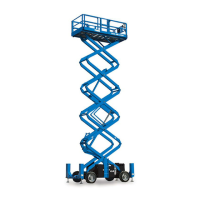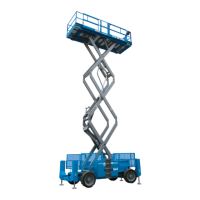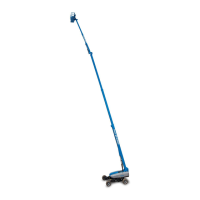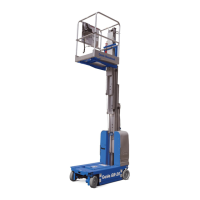Service and Repair Manual August 2021
Non-Steer Axle Components
72 GS
™
-30m • 32m • 30 • 32 • 46 • 55 Part No. 1309020GT
7-1
Drive Brake - Models with
hydraulic drive
How to Remove the Drive Brake
Note: When removing a hose assembly or fitting,
the O-ring (if equipped) on the fitting and/or hose
end must be replaced. All connections must be
torqued to specification during installation. Refer to
Specifications, Hydraulic Hose and Fitting Torque
Specifications.
1 Support and secure the entry ladder to an
appropriate lifting device.
2 Remove the entry ladder mounting fasteners.
Remove the entry ladder from the machine.
hazard. The entry
ladder will fall if not properly
supported and secured to the
lifting device.
3 Block the steer wheels.
4 Remove the cotter pin from the wheel castle
nut.
Note: Always replace the cotter pin with a new one
when removing the castle nut.
5 Loosen the wheel castle nut. Do not remove
it.
6 Center a lifting jack under the drive chassis at
the non-steer end of the machine.
7 Raise the machine approximately 2 inches /
5 cm. Place blocks under the chassis for
support.
Crushing hazard. The chassis
will fall if not properly supported.
8 Remove the wheel castle nut. Remove the
wheel.
9 Tag, disconnect and plug the hydraulic hose
from the brake. Cap the fitting on the brake.
Bodily injury hazard. Spraying
hydraulic oil can penetrate and
burn skin. Loose
n hydraulic
connections very slowly to allow
the oil pressure to dissipate
gradually. Do not allow oil to
squirt or spray.
10 Place a lifting jack under the brake for
support.
11 Remove the fasteners that attach the brake to
the drive chassis. Remove the brake.
Crushing hazard. The brake will
fall if not properly supported
when the mounting fasteners are
removed.
Brake mounting fasteners, dry
75 ft-
Brake mounting fasteners, lubricated
56 ft-
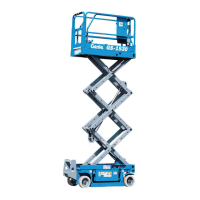
